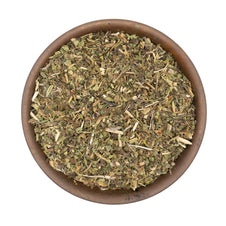
Comfrey Leaf
29 reviewsComfrey Leaf
29 reviews- In stock, ready to ship
- Inventory on the way
Country of Origin may differ from what is shown above.
Comfrey leaf has long been valued in Western herbalism as a wound-healer and musculoskeletal support herb. Known traditionally as “knitbone,” it's often used in salves, poultices, and oils for bruises, sprains, joint aches, and skin repair.
- Traditionally used to support healing of bruises, sprains, and muscle injuries
- Topically applied to soothe joint stiffness, tendon strain, and back pain
- Valued in poultices and salves for promoting skin repair and comfort
- Contains allantoin, mucilage, and rosmarinic acid – known for tissue regeneration and anti-inflammatory effects
- Suitable for use in short-term external preparations only
Infused Oil: Soak comfrey leaf in carrier oil for 4–6 weeks to create a base for healing salves and balms.
Poultice: Rehydrate dried leaf with hot water, mash, and apply to sore joints or limbs for up to 4 hours per day over several days.
Compress: Make a strong tea, soak a cloth in the infusion, and apply to bruises or strained tissue.
Salve or Cream: Combine infused oil with beeswax and other herbs to create a topical balm.
Bath Soak: Add strained infusion to a sitz bath for postpartum care or soak hands/feet for tissue support.
Comfrey is used externally for injuries, skin issues, and radiation burns. Though once used internally, this is no longer recommended due to the presence of pyrrolizidine alkaloids (PAs). Customers typically make their own infused oils and salves, apply poultices for joint recovery, or use it in blends for aches and tension.
Always use on unbroken skin, for short durations only. Not suitable for internal use, long-term application, or children. Store in a cool, dark place to preserve potency.
- Actions: Vulnerary, demulcent, anti-inflammatory, astringent, cell proliferant
- Systems: Musculoskeletal, integumentary (skin), circulatory (topical only)
- Energetics: Cooling, moistening, soothing
- Western Herbalism: “Knitbone” use for structural injury; topical use only due to PAs
- Common pairings: Calendula, St. John’s Wort, peppermint, arnica
This information is for external use only and not a substitute for medical advice. Do not ingest. Do not apply to broken skin. Consult a qualified practitioner before using on sensitive individuals or for extended periods.







